St. Paul's Evangelical Lutheran Church
The following is a history written about the humble beginning of St. Paul's Evangelical Lutheran Church. It was compiled from a collection of old German records of the church and also from information from the Lutheran Church Archives, along with legal documents. I have labored diligently to make this history as accurate as possible for the future generation of St. Paul's. Historian John Dixon said, "History should be exact, not pleasing," and so when we tell of mistakes we have made, we should remember that we speak of attitudes which existed in that period. We should not judge them; they were different times! Hopefully we have learned from the past to make the future a better time to live and grow.
--Burdette E. Walters
--1996
History Of St. Paul's Evangelical Lutheran Church
St. Paul's Lutheran Church in Shiloh Township, Grundy County, Iowa, had its earliest beginnings in the year 1870. This was the first Lutheran church in the area and at that time was 12 miles from any town.The humble beginning came on May 31, 1871, when the 10 charter members under the direction of Rev. Christian Hinken established our church.
1. Wilhelm Olthoff
2. Anton Olthoff
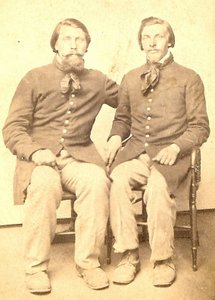 |
Wilhelm, left, and Anton Olthoff, right, in Civil War uniforms, donated the original land to St. Paul's |
3. Heine Jelschen Olthoff
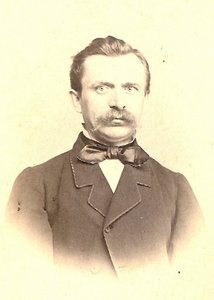 |
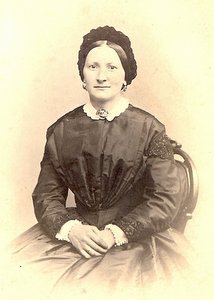 |
|
| Heine J. and Sara nee Kramer Olthoff | ||
4. Conrad Conradi (no photo available)
5. Weert A. Freese
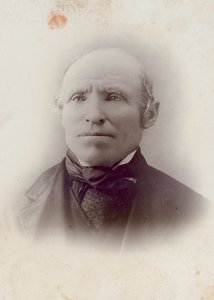 |
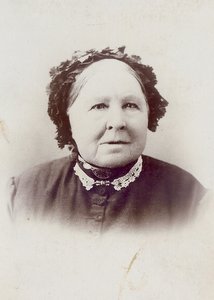 |
|
| Weert & Haukelina nee Heeren Freese | ||
6. Fred Etjen
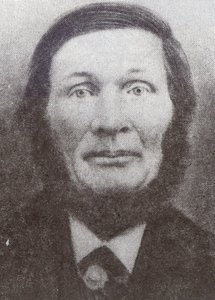 |
 |
|
| Johann Frederick and Catherine nee Nachtigal Etjen | ||
7. Egge G. Stoehr
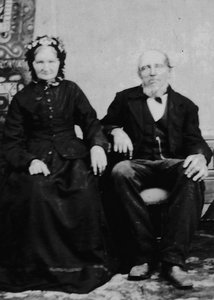 |
| Egge Gerdes and Lukelina nee Stuhr Stoehr |
8. Asjen Freese
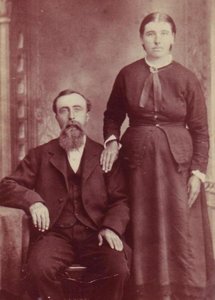 |
| Asjen and Hilke nee Frerichs Freese |
9. Fred Ahlers (no photo available)
10. Henry Knock
Church services at that time were held at the Colfax No. 3 school, which stood 1/2 mile south and 1 mile east of the present church. This schoolhouse can still be seen today at the Grundy County Museum at Morrison, Iowa. It was donated by the Eilert Walters, Jr. family of Wellsburg, Iowa, and has been restored to its original condition as it was in the 1870s.
The building committee was to be as follows: F. B. Ahlers, Weert A. Freese, Egge G. Stoehr, John Kramer and Wilhelm Olthoff. Wilhelm Olthoff did not accept the position; therefore, Conrad Conradi filled the vacancy.
Following is a list of the 54 members who contributed to this endeavor. George Wells, founder of Wellsburg, pledged $100, but actually paid only $50, according to the list. It would take the whole-hearted effort of everyone concerned to succeed. These pledges were to be collected by October of 1874.
The list is as follows:
Inside there was to be unbeaded woodwork flush with the bottom of the windows, and a 4 foot wide aisle in the center. The pews were to have solid backs, with rolled edges. Four benches were to stand around the altar with closed faces up and down, and be fastened to the floor.
The altar platform was to be 8'x10'x8" high. Furthermore, the pulpit was to be raised by two steps, 8" high with two sets of stairs, one on each side. The pulpit would stand on this platform.
"There is to be enough room between the pulpit and the back wall that one could stand there comfortably." The pulpit was to be decorated beautifully with panels and a stand for the Bible to be in the middle. There were to be two sets of steps to the pulpit, as mentioned before.
The altar was to stand on the lower platform and have the size and width of this platform, which was mentioned earlier. It was to have beautiful decorated panels in front and a door in the back. There was to be a cupboard in the back for storage. The building was to face east and the pulpit and altar were also to face east on the west end of the building.
The building committee was responsible for delivering the material to the church site.
The parsonage was to be 24'x14'x12' high and an addition 12'x14'x9' high of studdings 16" on center, with a porch 6'x12' long. The foundation was to be of flint stone. There were to be two good fireproof chimneys. The plaster was to be three coats thick, beautiful and permanent, with a stairway to the second floor, as needed. There were to be 10 windows with 10"x14" glass panels, 3 doors 2'8"x6'8" and 4 doors 2'6"x6'6", all to be encased by beautiful and well made molding. The roof was to be in the usual style, high pitch with cornish. The parsonage was to be done by July 1, 1873.
Two of the charter members of St. Paul's, Anton and Wilhelm Olthoff, had earlier promised 2 acres for the church - one acre for the church and parsonage and the other acre for God's acre. This action, the offering of the land, actually spurred the decision to erect a church. The deed was signed June 23, 1873, and recorded July 7, 1873.
Fred Ahlers, Conrad Conradi, Wert Freese, Asjen Freese and Henry Knock
On January 11, 1874, St. Paul's Evangelical Lutheran Church was dedicated. Besides our own Pastor Goettlieb Loeffler, guest pastors were Pastor Ficken, Pastor Brinkemeier and Pastor Dippel. Also shortly thereafter, on April 28, 1874, it was decided to erect a fence around the cemetery and one around the church and parsonage.
Pastor Loeffler left our congregation on October 19, 1874.
From the beginning, St. Paul's was affiliated with the Wartburg Synod. This synod was organized with the intent of maintaining the German language and tradition in the German Lutheran churches in the United States. We were proud of being a member of such a fine synod.
December 21, 1874, marked an important milestone in our church history, one of which the congregation was very proud. Two notes, one to Lush & Carton for $274.30 and one to John Rath of Ackley for $403.75, were paid in full.
On March 25, 1875, Pastor Matthew During became our pastor. Pastor During was born in Cottbus, Prussia, on October 6, 1812. He was ordained in the year 1849. He died at Mt. Pulaski, Illinois, on March 14, 1890, of heart disease and is buried there.
In May of 1875 the youth of St. Paul's were proud to donate 1 rocker, 1 armchair, 1 round table, table covering and a church Bible to the congregation. In the same year of 1875, the Wartburg Synod also had its beginning.
The board took action concerning the fence situation on April 28, 1875. The fence was to be put around the cemetery, church and parsonage. For the cemetery, owners of lots were to contribute. Everyone must contribute even if the lot was as yet vacant. The congregational members were to contribute $2.50 for their part of the fence around the church and parsonage. The total assessed could not exceed $3.25 total per member. If a member did not have the ready cash, they must give a promissory note to the congregation. This was to be paid by May 15, 1875.
It was also decided that all those who contributed to the salary of the pastor could send their children to the school free of charge. Non-members could send their children to the school, but had to pay a fee of $2.00 per child, even if the children didn't come to school very often.
Pastor During left our congregation on Palm Sunday, March 25, 1877. He and his wife and daughter moved to Dallas City, Illinois. Shortly after, on April 19, 1877, Pastor Meneke Janssen Tjaden came to our church from St. Peter's congregation in Ripley County, Indiana. His annual salary was $300 per year.
Pastor Tjaden was born in Leer, Eastfriesland, in 1821. He learned the trade of basket weaving. Shortly after he fought in the war of 1848 against Denmark, he married Minna Tjaden and came to America. Tjaden wanted to study for the ministry, but he had no means. After landing in New Orleans, he worked for a short time, and then moved to Quincy, Illinois, where he set up in this trade. At the same time he took instruction from a Lutheran pastor. He later attended the Seminary at Springfield, Illinois, and was ordained in the year 1860. He was one of the founders of the Wartburg Synod. After serving our congregation for two years, he left on April 21, 1879. From 1879 - 1882 he went back to St. Peter's Evangelical Lutheran Church (today St. Peter's United Church of Christ) in Osgood, Indiana. In 1882 he moved to Nebraska and joined the Nebraska Synod as a charter member. While in Wellsburg, Pastor and Mrs. Tjaden lost an infant son on October 1, 1877. This baby was the first burial in the cemetery lot reserved for the pastor of our congregation, Lot 16.
On October 17, 1878, a son was born to Pastor M. J. Tjaden and his wife Minna Tjaden, nee Tjaden. The son was named after his half-brother who died in 1870, whose name was Johann Christian Tjaden. The infant was baptized on October 31, 1878, with the elders of the congregation as witnesses: Fr. Ahlers, Fr. Etjen, Heine Olthoff, and Wert Freese. Pastor Tjaden retired from active service in 1893 and died October 17, 1902, at Lennox, South Dakota.
 Pastor and Mrs. Meneke Janssen Tjaden
Pastor and Mrs. Meneke Janssen TjadenIn May of 1878, a disease broke out in the Schmidt home. Everyone was infected but no one died. J. K. Brouer contracted the disease while visiting in the Schmidt home and brought it back to his house. Mrs. Brouer died and was buried at the Van der Lass church. Both daughters of Brouer, Mrs. Gerd Stoehr and Mrs. Wilhelm Stoehr visited their mother. In July of 1878 one of Gerd Stoehr's sons, about 4 1/2 years, died. One of Wilhelm Stoehr's daughters, about 10 months old, died. The funerals took place in the evening, after dark. Later, on September 15, 1878, another of Gerd Stoehr's children died, but this was not of the disease, but of coughing.
(The above paragraph was taken from a special page in the old record book, designated as important items to remember.)
Pastor W. G. Weissinger came to St. Paul's on May 28, 1879. He was to receive $300 per year. On September 18, 1879, St. Paul's became incorporated, and Weissinger left our congregation on November 27, 1879, after only 6 months.
At the April 3, 1883, board meeting, 3 items were discussed:
1. Fence around the parsonage needed to be repaired.
2. Husinga was hired to repair the fence.
3. Eisenschmid wanted locks on the door in the parsonage.
At the July 2, 1883, board meeting 4 more items were discussed:
1. Rotten fence posts on the cemetery were repaired.
2. Lightning rod on the church was straightened.
3. Cemetery gate had to have a new spring.
4. Screen doors were needed on the church for ventilation.
In 1883 it was also decided that school would be held again next year. If there were fewer than 3 students that showed up, Eisenschmid could teach them. School would start 6 weeks after the harvest.
While Pastor Eisenschmid was here, St. Paul's suffered its first tragic blow. On July 26, 1883, the parsonage burned. Pastor Eisenschmid moved in with the Wilhelm Friederick Koch family while a new parsonage was under construction. This new parsonage was to be built on the same location. The new house was to have flint stones in the basement under the main structure. The back side of the house was also to be 1' higher, and the foundation was to be 1' high at the highest point above ground. The Eisenschmid family moved into the new parsonage in October of 1883. On December 27, 1884, the Eisenschmid family left our congregation. Pastor Eisenschmid died at New Douglas, Illinois, on April 9, 1888. He was 38 years, 6 months and 19 days old.
On March 1, 1885, Pastor Matthew Kossick took over the command of St. Paul's. Pastor Kossick is probably one of the least remembered pastors of our congregation, but by far is the most world famous!
(Mato Kosyk) Matthew Kossick was born in Werben (Kreis Cottbus) on June 18, 1853. He was the first child of Georg and Maria nee Schillo Kossick. With the help of Pastor Friedrich Petko, he was able to study at the Friedrick Willhelm gymnasium in Cottbus. After completion of his studies there, he found employment as an official on the Leipzig-Dresden Railway. In 1876/77 he returned to Lower Lusatia, and from 1881 became one of the editors of the Bramborski Casnik. In 1883 he left his homeland and immigrated to America on October 31. He studied for the ministry at Springfield, Illinois, and at the Chicago Seminary under Severinghaus, founder of the Wartburg Synod. He was licensed for our congregation on March 10, 1885, and later ordained, June 14, 1885, as a pastor of the Wartburg Synod, actually after he had been serving as pastor of St. Paul's.
 Pastor Matthew Kossick
Pastor Matthew KossickPastor Kossick was one of the few left of a vanishing race, the "Wends." For him, German was an acquired language. In his youth he wrote four volumes of poetry in the Wendish language. By his marriage to Anna Wehr in November of 1890, he acquired some wealth. Matthew and Anna had one son, Georg Kossick.
On September 26, 1894, Kossick became a citizen of the United States. On August 23, 1915, Georg Kossick, the only son of Pastor Matthew Kossick fell off his horse while crossing the Kiamichi River. He apparently fell while stooping over to fix his saddle. After he fell from his horse he sank only once and was pulled out by his friends. He was taken to a nearby house and died that same evening. Mrs. Kossick often sat in the evening by her son's grave, located on their farm near Albion, Oklahoma, and cried. She was later buried beside her son.
Pastor Kossick had retired from the ministry in 1913. Matthew Kossick continued to write poetry in his latter years. In 1946 an article published listed Mato Kosyk (Matthew Kossick) as one of, if not the most important, Lower Sorbian poets, even though most of his life was spent in the United States.
R. Dalitz and G. Stone wrote, "The Lutherans in the Wellsburg parish were mainly immigrants from East Friesland, and their language must have given rise to some difficulties of communication between Pastor Kosyk and his flock. This may have been in part, at least, the reason why Kosyk resigned this position and left the Wartburg Synod after one year. He often said he had difficulty with the English Language. Another reason for his resignation was ... to visit his parents and family at Werben ... and his brother Kito had recently died on June 1, 1886. In any event, Kosyk resigned his pastorate at Wellsburg on the 29th of August 1886 and set off for his long journey across the Atlantic." Kossick returned to America in 1887. Before his death on November 22, 1940, he had given all his land to the Midwest Synod. Besides his gift to the Synod, he benefited others in foreign lands.
 Rev. Dr. Joseph H. Georgi
Rev. Dr. Joseph H. GeorgiIn the Fall of 1886, extensive work was done on the paths in the cemetery.
On September 1, 1890, Frederick G. Diekhoff came to our church as pastor. Pastor Diekhoff served our congregation until September 2, 1894. He died in Diller, Nebraska, on May 4, 1917, and is buried there. He was 52 years old. St. Paul's purchased the barn from Pastor Diekhoff when he left in 1894.
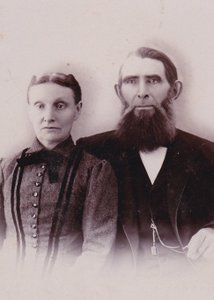 Pastor and Mrs. F. G. Diekhoff
Pastor and Mrs. F. G. DiekhoffOn October 11, 1894, Pastor Otto Saalborn arrived at our church, and preached his first sermon on October 14. His salary was $350 per year. Rev. Saalborn was born on December 5, 1859, at Schniebus, Germany, where his father was Rector of the city school. Later his father held that position in the town of Tizwauk and Dorau, while serving as minister of the gospel and preaching in the Cloister church of that place.
During this period, he entered the gymnasium and later the State School at Phoroa and from there he attended the gymnasium at Sorau where he passed a splendid examination. Sometime later he became a student at the seminary in Berlin. There was a great demand for theologians to serve as ministers of the Gospel. He answered the call and with others emigrated to this country. Having arrived here, he at once went on his journey to Chicago where he entered the seminary. After a short period he received a call to become minister to a congregation at Macon, Missouri. He was ordained in 1885. Besides our congregation he served as minister at Holland, Iowa. From there his family moved to Tea, South Dakota, where he served the Lutheran Congregation for four years. There he breathed his last on the morning of September 30, 1911, at nine o'clock, at the age of 51. He left to mourn his demise a wife and five children, besides a host of friends. The funeral services were held at the Tea and Harrisburg Churches where he was pastor. His remains were laid to rest at the Harrisburg Cemetery, after four ministers of the Lutheran Church conducted the service.
During Saalborn's leadership several important events took place at our church. In 1894 our first choir was organized, and also the paths were cleaned on the cemetery. In 1895 the church built a cook house for the church, and began a drive to purchase our first organ. The organ was a Cornish Organ, which was made in Washington, New Jersey. It was to cost $90 and arrive in mid-December of 1895. It arrived shortly after Christmas. Pastor Saalborn took care of the collections for the organ himself. He collected $100.
1896 was a very important year to St. Paul's. We were to celebrate our 25th anniversary. For this monumental occasion, a tower was built, no less than 60 feet high. Also a bell was purchased by the congregation which cost almost as much as the organ. The bell cost $75.00. The ceiling in the church was vaulted, which was a nice improvement. (See photograph of interior of 1st church.) The congregation also made a gift of an altar Bible to the church.
On March 31, 1896, the bell and tower were dedicated by Pastor Saalborn, Pastor Voss, and Pastor Siefkes. In the afternoon Pastor Frederick Wiegmann and Pastor Bieyer of Holland conducted the 25 Year Jubilee Service. Pastor Voss preached on Rev. 21:1-5; Pastor Wiegmann preached on I Corinthians 13:13; and Pastor Bieyer preached on Rev. 3:11, while our Pastor Saalborn gave a summary of the History of St. Paul's. A collection at the Jubilee Service was taken for the Seminary in Chicago, which netted the sum of $25.85. The tower was insured by a company in Freeport, Illinois.
On April 26, 1896, after the services, the cornerstone ceremony was held. After a song, the stone, 6"x8"x5", was laid. Pastor Saalborn left our congregation in the fall of 1897.
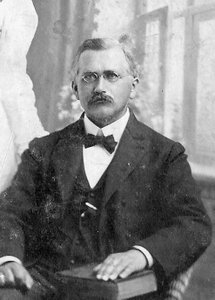 Pastor Otto Saalborn
Pastor Otto SaalbornFriedrich Conrad Wiegmann came November 24, 1897. He was born on October 13, 1857, in Westphalia, Germany, one of a family of five boys and one girl. Two of his brothers, Conrad and Henry, came to America. Conrad located at Ackley, Iowa, and Henry located at Bristol, Iowa. Two other brothers, William and August, served in the German army. His sister Minnie never left Germany.
Friedrick Conrad Wiegmann was a teacher in Germany, but decided to quit and see the world. He made several ocean trips, working his way as an oiler, and finally landed in London. There he had a job in a sugar refinery. He had a maternal aunt and uncle named Conrad Conradi who had gone to America and located at Wellsburg, Iowa. Frederick Conrad Wiegmann decided to visit his aunt and uncle in Wellsburg. His aunt, Mrs. Charlotte Wiegmann Conradi, persuaded him to study for the ministry, so he enrolled in Maywood Seminary in Chicago, Illinois. He graduated and was ordained in 1888, at the age of 31.
On April 7, 1890, Pastor Wiegmann married Bertha Hammerschmidt. They were married by Dr. Severinghaus and Dr. Neve of the Maywood Seminary.
While in Wellsburg, Pastor Wiegmann was instrumental in building our church choir to a well rounded unit.
After he left Wellsburg in 1902, he served parishes in the "German Nebraska Synod." During this time, Frederick Wiegmann met his untimely death while attending a Synod convention in Hastings, Nebraka. He stepped off the curb in the pouring rain and was struck by a car driven by Otto Struss. Pastor Wiegmann struck the back of his head on the curb when he was thrown back. Otto Struss took Pastor Wiegmann to the hospital himself. Frederick Conrad Wiegmann died at 2:30 a.m. on September 15, 1917.
|
--Pastor F. C. Wieggmann & Choir ca. 1901-- Back row left to right: Henry Harms, John Stoehr, Eggo Stoehr, George I. Harms, William Koch Sr.; Third row left to right: Mrs. John Schoon, Mrs. Cuno Stoehr, Mrs. Helmer Kruse, Mrs. John Brower, Mrs. Eggo Stoehr; Second row left to right: Henry Koch, Ebe I. Harms, Cuno Stoehr, Helmer Kruse, Fred Terfehn; First row left to right: Andrew Wiegmann (son of Pastor F. C. Wiegmann), Mrs. Henry Giesking, Mrs. John Stoehr, Pastor Frederick Conrad Wiegmann, Mrs. William Bettenga, Mrs. Ebe I. Harms; Andrew Wiegmann was not a member of the choir, but wanted to be on the picture very badly. When the photographer was ready to take the picture, Mrs. Giesking and Mrs. Stoehr felt sorry for Andrew and slid over quickly. Andrew came in on a skid just as the photographer snapped the picture. Pastor Wiegmann was not amused, but the photograph was taken. |
 |
Two children were born to the Wiegmanns while they were in Wellsburg. One was Fred C. Wiegman, born February 15, 1899. This son of our congregation became president of the Ohio Synod of the United Lutheran Church. Dr. Wiegman met his untimely death when a truck bound in the other direction veered across the center strip of a four-lane highway and collided with Dr. Wiegman's car in Akron, Ohio, December 3, 1957.
During this time, on April 7, 1902, it was decided to remodel the parsonage. It was decided that the existing parsonage was going to be turned, and on the North side, a new house was attached. This house was to be 16'x28'x14' high. The least expensive bid for the job was $775. The building committee consisted of Pastor Wiegmann, Heinrich Olthoff, August Asche, Harm Harms and Ibeling Harms.
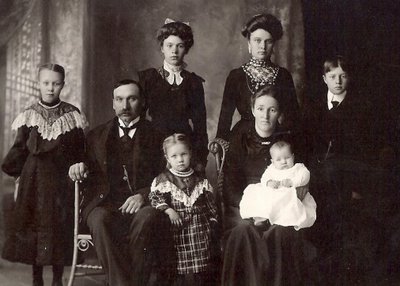 |
--Heinric Olthoff family-- Back row left to right: Bertha Christine (Mrs. Louis Kaiser), Sara (Mrs. Harry Mass), Heine Olthoff; Front row left to right: Anna (Mrs. Anton Venenga), Heinrich Olthoff, Christine (Mrs. George H. Geerdes/Mrs. Henry Buskohl), Maria nee Asche(r) holding Liddie Marie (Mrs. Harry Knock) |
 |
--August Asche family-- Back row left to right: Lena (Mrs. James Dekker), Maria (Mrs. Heinrich Olthoff), Wilhelmina (Mrs. Omke Harrenstein), Henry Asche(r) Front row left to right: Conrad Herman "August", August Asche(r), Christine nee Berneking, Sophia (Mrs. Wessel Jutting) |
Julius Koehler came November 16, 1902, to St. Paul's. Pastor Koehler was here for a short time, leaving in 1904. One reason Pastor Koehler might have left was the fact that he didn't want to join the Wartburg Synod.
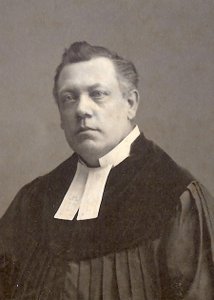 Pastor Julius Koehler
Pastor Julius KoehlerFrom 1904-1905 our congregation was under the leadership of Pastor R. Kuhne, an ad interim pastor from Ackley, where he served from 1901-1907. Pastor Kuhne also served at Bethal Lutheran in Parkersburg, Iowa.
On March 8, 1905, our congregation sent a call to Pastor Carl Heinrich of Walsh, Illinois. His salary was to be $500 per year, without transportation costs. Pastor Heinrich was installed by former Pastor Otto Saalborn and Pastor Kuhne on June 5, 1905.
Pastor Heinrich was born in Radschen, East Prussia, on February 10, 1863, the son of Johnann and Elizabeth (nee Roeder) Heinrich. He married Theodora Sophia Thorelsen on March 18, 1893. He was ordained in Brecklum, Germany, on March 1, 1893. Shortly afterwards they left for the United States. When they arrived in Illinois, he took a six month course and became a member of the Wartburg Synod, also in 1893.
Pastor Heinrich was the father of six children: Johannes, Carl, Phillipp (Theodore), Gustav, Louise and Marine, who later married Pastor Arthur Huneke. Martha Mueller, a niece of Pastor Heinrich also made her home with the family until her death in 1910.
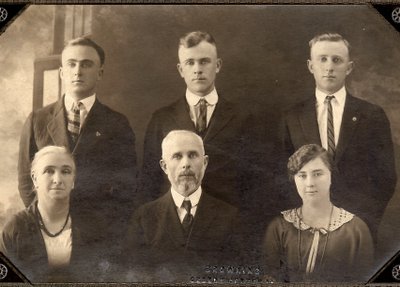 |
--Rev. and Mrs. Carl Heinrich family-- Back row left to right: Gustave, Carl, Johannes Front row left to right: Theodora, Rev. Carl Heinrich, Marine |
During the 30+ years Pastor Heinrich served our church, we had many improvements and additions. Heinrich was instrumental in beginning a Ladies Aid Organization in the 1920's and organizing the Sunday School Picnic.
|
--Ladies Aid Organization, 1923-- Back row left to right: Mrs. Ebe Harms, Mrs. Louis Kaiser, Mrs. John Stoehr, Mrs. Christ Muller, Mrs. I. J. Harms, Mrs. Harry Maas Middle row left to right: Mrs. Sam Claassen, Mrs. Henry Ascher, Mrs. Claus Claassen, Mrs. Albert Loots, Mrs. John Schoon, Mrs. Heiko T. Neessen, Mrs. Henry Rust Front row left to right: Mrs. Heinrich Olthoff, Mrs. Wilhelm Stoehr, Mrs. Thomas Neessen, Mrs. August Ascher, Sr., Mrs. Sieb Diekman, Mrs. Rev. Carl Heinrich, Mrs. John Harms |
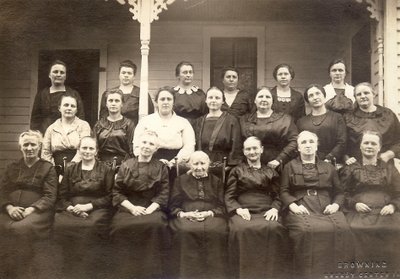 |
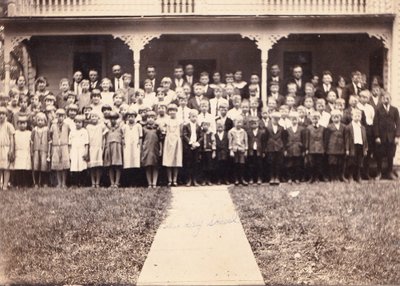 Sunday School Picnic in the early 1920's
Sunday School Picnic in the early 1920'sPastor Heinrich also built and played his own pipe organ, which served our congregation many years. Since our first organ in late 1895, all the pastors up to 1937 were qualified to take charge of the church music department.
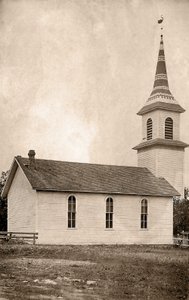 First church with swan
First church with swan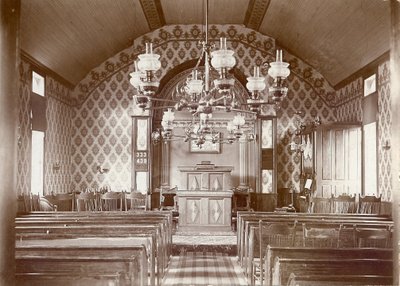 Interior of the first church, showing pastor's organ
Interior of the first church, showing pastor's organAlso under Pastor Carl Heinrich St. Paul's built a new church in 1914.
On April 6, 1914, the board decided that if the bid for the new church was to be over $5,000, then the job should go out on bids. After long negotiations, Eberhart was hired. The architect was John R. Gier. The new church would have a furnace in the basement and it would also have a balcony. It was decided to skid the old building west, and then have a new church constructed on the same location. This was to be done by the contractors, the Eberhart firm from Dubuque, Iowa. The cost of this project was agreed upon at $5,225. It was found that the old tower could be saved and used on the new church.
 Digging the basement for the second church building, 1914
Digging the basement for the second church building, 1914On April 15, 1914, it was agreed that the carpenters were to build a new tower, anyway, for $679, but they were to use the wood from the old tower. The swan on the old bell tower would be moved and placed on top of the new church steeple. At this time, anyone who could put in a day's work to help the project did, and anyone who had equipment that could be used was asked to volunteer. Engelke Engelkes was chosen as supervisor for the construction of basement and foundation walls. Henry Harms made all the cement blocks for the foundation. Now the bill owed to Eberhart was $5,904, and for Engelke Engelkes $75 for the basement, for a total of $5979.
On May 24, 1914, the Cornerstone Dedication was held. The cornerstone was laid for the new church, with a document containing the history of the organization and developments, along with the list of current members. The pastor from Holland gave a nice sermon and Pastor Heinrich read the document that was to be placed in the wall.
July 6, 1914, the congregation discussed the purchase of pews, altar and pulpit. They decided to order these from the firm of Mr. W. & E. Schmidt from Milwaukee, Wisconsin. The end pieces and back of the pews were to be made of oak and elm. The price would be $350 for the pews and $175 for the altar and pulpit. Furthermore, Aeilt Hoffmann had promised to pay for the bell. The bell cost was $100 plus $6 freight.
On October 10, 1914, it was decided to have a sale of the old church. On that day they received a total of $281.77. The church brought $247 and was purchased by Mr. DeGroote. The stove and pipes hold for $34.77.
On October 15, 1914, the dedication ceremony was held. Guest speakers were former Pastor F. C. Wiegmann, along with Pastor Pfeifer of Holland and Pastor Drake of the Presbyterian Church, also of Holland. The collection on Dedication Sunday was $272.77.
| The total cost of our new church was | $7,223.04 |
| Income for the new church was | $6,519.14 |
| Net debt remaining | $630.90 |
This structure was nothing to be ashamed of and ranked best in the territory and in the rural section of the Wartburg Synod.
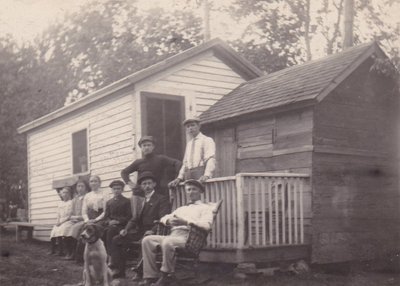 Eberhart Crew
Eberhart Crew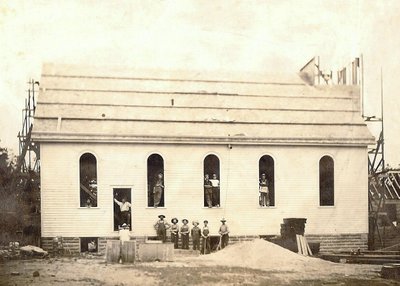 Second church under construction
Second church under construction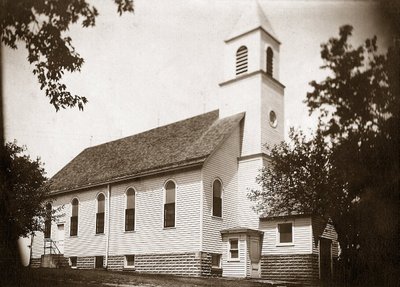 Second church completed
Second church completed Rev. Heinrich seated by the altar in the second church
Rev. Heinrich seated by the altar in the second churchWhen the Eberhart crew was finished with the construction of the church they decided to sell their brown milk cow that they had with them. Mr. and Mrs. Louis Kaiser bought the brown cow and their daughter Mary remembers the name she gave to the cow. She said the cow had the first stall in the barn and its name was none other than Eberhart.
In 1926 a new well was dug at St. Paul's which supplied the parsonage and the church.
Pastor Heinrich resigned at pastor June 2, 1936. He was succeeded by Pastor Arthur Huneke, who later married Marine Heinrich, daughter of Pastor Heinrich.
Pastor Arthur Huneke was a candidate from Maywood Seminary by Chicago, Illinos, who could preach in both English and German. He was born September 13, 1900, in Batesville, Indiana. His undergraduate work was completed at Carthage College in 1933, and then from the Lutheran Theological Seminary in 1936 with his B. D. Pastor Huneke was ordained on June 21, 1936, in the Wartburg Synod. Pastor Huneke came to Wellsburg to give his interview, including a trial sermon. Afterwards he was taken to the railroad station by Carl Heinrich, Jr., to return to Indiana. Carl asked Huneke if he had any money and after a short silence, Huneke said, "Yes." Carl noticed his hesitation and asked him how much? Huneke said, "A nickel." Arthur Huneke became pastor of our church on June 5, 1936.
A motion was made by William Koch, Sr., second by Heinrich Olthoff to have one Sunday English and the next Sunday English and German, on March 17, 1937.
Pastor Huneke suffered two severe personal losses while in our church. First his daughter was stillborn and then shortly afterwards, his beloved wife Marine Heinrich Huneke died. Arthur Huneke resigned to take a position at Wine Hill, Illinois, on July 14, 1938. His late wife's parents went with him to Illinois. The Heinrichs moved back to Wellsburg in October of 1940. Pastor Heinrich passed away on Christmas Day, 1940, and his wife shortly afterward on February 9, 1941.
Aurelia Heinrich Harringa remembers, "My grandparents faced a hard and tragic, but very special life. Very poor, but material possessions were never important. My grandfather was a talented, quiet, kind and gentle man who never wavered in his service to the Lord. He was an accomplished musician, playing the piano and building a pipe organ himself. He and grandmother spoke High German which, as a child, I had difficulty understanding. But the times I spent at their home were precious. There were always daily devotions and a Bible laying on the center of the table. Much time was spent in prayer. I was in awe of my grandfather. Grandmother was busy cooking and keeping house and also very active in women's activities in the church."
Pastor Huneke married Anna Lohman and later they had two children, Darlene Malasek and Leonard. Pastor Huneke died February 3, 1983, and his second wife, Anna, on January 27, 1988. They are buried in the Paradise Cemetery in Steelville, Illinois.
The year of 1939 was an eventful year for our church, with undercurrents that led to one of the saddest times in our church history.
On January 11, 1939, a committee was appointed to investigate the water situation and move the church to Wellsburg. George Diekman, Herman Harrenstein, John Heinrich, Ibe Harms, Sr., and H. J. Vahlsing served on the committee. A meeting was held January 19, 1939, at 7:00 p.m. to hear the results.
On Saturday, February 12, 1939, in the early afternoon, a terrible blow was struck to St. Paul's. The church was completely burned to the ground after a sudden explosion. This loss was a double loss, since the new organ that had recently been installed was not insured.
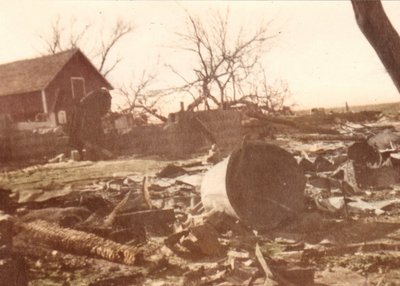 The Church bell after the fire. The bell was cracked.
The Church bell after the fire. The bell was cracked.On March 7, 1939, a special congregational meeting was held with Rev. Dr. Belter, vice president Schmit, and Rev. Goeken in attendance as representatives of the Wartburg Synod.
Rev. Schmit gave a short talk explaining the United Lutheran Church constitution. A vote was taken and passed by 3/4 of the congregation present to accept the new constitution and be members of the Wartburg Synod.
After a talk by Rev. Goeken on the disadvantages and Rev. Schmit on the advantages of moving the congregation to Wellsburg and building a new church there, a vote was taken to build at the old location. Twenty voted for and 34 voted against. A motion was made and seconded to build in town.
After another talk by Rev. Goeken on the advantages of being in town another vote was taken. Forty-three voted for, and 20 voted against. Motion was carried and a committee was chosen to look for a new location.
On March 12, 1939, a special meeting was held to move Rev. Sager and family to town. Motion carried unanimously! (Frederick J. Sager made application to join the United Lutheran Synod in Iowa, of the United Lutheran Church in America, at the 87th Annual Convention held May 5-7, 1941.)
On May 15, 1939, a special meeting of the Wartburg Synod was held to accept the resignation of Pastor Friederich J. Sager from St. Paul's, effective August 5, 1939. A motion was made by Ebe Harms, seconded by William Koch, Sr., to accept the resignation. Motion carried.
St. Paul's Evangelical Lutheran Church held their regular meeting on July 3, 1939. Roll call was answered by 47 members. Carl Heinrich, Jr., was elected Secretary. A motion was made by Henry Aalfs and seconded by Heiko T. Neessen that we rescind all former actions of March 7, 1939, meeting at Wellsburg in regard to building our church in Wellsburg. Motion carried unanimously.
Motioned by John Harms and second by I. J. Harms to declare all actions taken with reference to changing the Articles of Incorporation as an illegal act not in accordance with the rules for changing the same and in a meeting illegally conducted and with an illegal chairman. Motion carried unanimously.
On August 15, 1939, at an open meeting of St. Paul's, a motion was made to appoint the building committee, to consist of John Harms, William Koch, Sr., Charles Etjen, George Harms, Carl Heinrich, George Geerdes and Heiko T. Neessen.
A motion was made to have Rev. Freitag of Holland conduct services August 20, and on every Sunday thereafter, in the Wellsburg School.
On October 3, 1939, the building committee met and decided to let a contract for the new church to include labor, lumber, plumbing, paint and electrical wiring. The contract was let to the lowest bidder:
| Walter Zech | $7,850.71 |
| Emil Brandes | $7,618.23 |
On October 31, 1939, the building committee appointed 4 committees, as follows:
| Plumbing committee: | Heiko T. Neessen and Carl Heinrich |
| Light Fixture committee: | Chas. Etjen and George Geerdes |
| Church bell committee: | Charles Etjen, Carl Heinrich and George Harms |
| Church furniture committee: | John Harms and Will Koch |
At a joint meeting of the church board and the building committee on February 10, 1940, it was decided to have Emil Brandes make 6 pews for the balcony and tables and benches for the basement of the church. Also 20 new pews were ordered 12 feet long and 2 that were 10 feet long. They had No. 132 ends and No. 9 seats. This was the cost $563 F.O.B. Wellsburg from Ossit Church Furniture Co., Janesville, Wisconsin. The altar came from the Klagstad Art Studio in Minneapolis, Minnesota.
At this same time it was moved to improve one room in the parsonage for a bathroom.
At the other Lutheran church in Wellsburg, a regular semi-annual meeting was held on July 3, 1939. "A motion was made by George Diekman and seconded by Henry Rust to sever relations with the Wartburg Synod. Ernest DeNeui made a motion, second by Mrs. H. J. Vahlsing to join the United Lutheran Synod of Iowa. Motion carried. This church, St. John's Lutheran, later joined the Missouri Synod."
A minority left our congregation, but those faithful continued at the old location and remained true to the old Wartburg Synod.
The treasurer and consistory of St. John's church brought suit against the treasurer of St. Paul's for failure to turn over the $7,500 insurance check for our loss and also for failure to sign checks for hymnals, payment for Pastor Sager, etc. There were no less than three new separate law suits filed in the District Court in regard to the building of our church.
The cornerstone ceremony was held October 29, 1939. The church was not ready by Christmas of 1939, but Pastor Heinrich came back from Illinois to conduct the entire service, including the children's program.
 Church under construction
Church under construction Pastor Heinrich in the church at Christmas, 1939
Pastor Heinrich in the church at Christmas, 1939The dedication services for the new church were held on September 8, 1940. The former pastors Heinrich and Huneke, along with our neighboring pastor, Pastor Freitag of Holland, Iowa, were the speakers of the day. Our new pastor, F. Albin Heinz, read the service of dedication and presided at the other services. Over 500 members, neighbors and friends of St. Paul's formed the audience on this memorable day.
Pastor Franz Albin Heinz became our next pastor. He came to us from Syracuse, Nebraska. He was called July 3, 1940, and took office July 18, 1940. His installation was September 8, 1940. Pastor Heinz was born on September 14, 1890 in Meiningen, Thuringia, Germany, the son of Rudolph and Pauline nee Eichhorn Heinz. He was educated in schools there and was trained for the banking business, graduating from business college in 1908. From 1908-1912, he was employed by the bank in Meiningen, Germany. In 1912, through the influence of friends in the clergy, he chose to leave the banking profession and came to America to enter the Gospel ministry.
He attended Western Theological Seminary at Atchinson, Kansas, from 1912 to 1915. In July of 1915, Pastor Heinz organized Christ Evangelical Lutheran Church in Salem, South Dakota. In 1965 he had the honor and privilege to return to Salem for the 50th anniversary of the congregation.
On October 19, 1916, Pastor Heinz was ordained at the Kansas Synod convention in Trinity Lutheran Church, Lawrence, Kansas. He then accepted a formal call to the church in Salem, South Dakota. On January 2, 1921, he accepted a call to St. John's Lutheran Church in Lancaster, Kansas. He was married to Adeline Matthias, one of the members of his congregation on December 28, 1921.
From 1922 to 1925 he served Frieden's Lutheran Church in Papillion, Nebraska. Then he moved to Columbus, Nebraska where he served the Evangelical Protestant Church consisting of Lutheran and Swiss Reformed members. Out of this congregation Pastor Heinz organized Trinity Lutheran Church which grew to over 1,100 members by 1930. In that year he was called to St. John's Lutheran church in Lanham, Nebraska, where he served until 1934. His next pastorate was at First Lutheran Church in Syracuse, Nebraska. In 1940 he came to Iowa to serve St. Paul's Church in Wellsburg. Illness, due to a painful accident, forced Pastor Heinz to relinquish full-time service in the ministry in 1943.
Pastor Heinz celebrated his 50 years of ordination at St. Paul's Lutheran Church in Mason City, Iowa, on October 9, 1966. Pastor Heinz was the father of 3 boys and 1 girl: Albin Matthias, Paul Luther, Sigrid Harter and Norma Joyce Heinz. Pastor Franz Albin Heinz died in Mason City, Iowa, at "The Manor" on July 19, 1972.
On June 28, 1940, a decision was made to have a German service every third Sunday. Pastor Heinz, who was to come the next month was the last pastor to serve our church who could conduct the services in German. Pastor Heinz was actually sent to us by the Synod to show that someone born in Germany could learn the English language as he did.
In 1941 St. Paul's had a new garage built and we also celebrated our 70th anniversary on June 1. We were proud to have the son of former Pastor Wiegmann, Dr. F. C. Wiegman, conduct an English sermon in the afternoon.
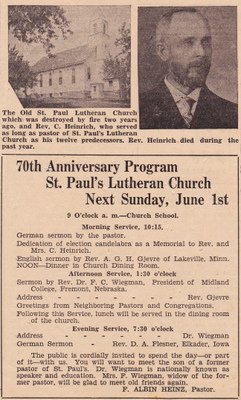 Newspaper coverage of our 70th Anniversary
Newspaper coverage of our 70th AnniversaryOn August 2, 1943, Pastor Heinz resigned, due to ill health.
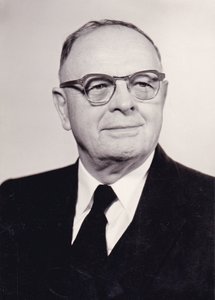 Pastor Franz Albin Heinz
Pastor Franz Albin HeinzPastor Arthur William Malin was our next pastor coming to us from Lake Geneva, Wisconsin. He was born June 25, 1905, near Montello, Wisconsin, and graduated from Central High School in Scranton, Pennsylvania in 1929. He continued his education at Concordia College, in Springfield, Illinois, in 1930 and graduated in 1932 from the Western Seminary at Fremont, Nebraska. He was ordained April 5, 1932, at Hays, Kansas. His mother, Paulina Mielke Malin, died in 1932 and his father, Pastor F. W. Malin lived with his son while he was in Wellsburg. Pastor A. W. Malin had 4 boys and 1 daughter. Pastor Malin was instrumental in organizing the Luther league in our church.
During his life as pastor, A. W. Malin rehabilitated and established 2 defunct rural churches and re-opened a closed church which merged with another Lutheran body to form a good congregation.
On April 5, 1945, the choir of our church wore robes for the first time. Our choir presented a new selection every Sunday and also a cantata, "The Holy Advent."
On May 22-23, 1945, St. Paul's Lutheran Church was proud to host the 70th Annual Convention of the Wartburg Synod of the United Lutheran Church in America.
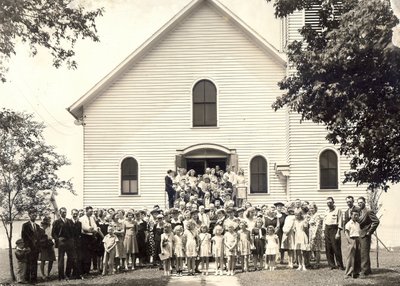 Congregation after church at the 75th Anniversary
Congregation after church at the 75th AnniversaryOn November 11, 1947, the insurance on the present parsonage was raised to $15,000 for fire and lightning.
At the January 6, 1948, annual meeting, it was voted to give Gertie DeVries $100 for being pianist and Esther Muller $25 for being assistant pianist.
On May 2, 1948, at the congregational meeting it was decided to build a new parsonage. The motion was made by Gratus Ross and second by George Harms. Wallace Meyer presented two drawings for the parsonage; it was decided to accept plan 2. On October 18, 1948, the board decided to have a sale of the old parsonage, "next Saturday at 2:00 p.m. to sell sink, storm windows, 6" siding, summer kitchen, lath, timbers, etc." Motion carried.
On January 14, 1949, Pastor Malin's salary was increased to $2,500, with a $500 bonus. While the parsonage was under construction the Malin family lived in the church basement.
The May 26, 1949, congregational meeting shows the total expense of the new parsonage at $11,271.92. (By January 1950 the cost was recorded at $11,915.99.)
The choir bought new chairs for the choir and also new robes in July, 1952.
Pastor A. W. Malin left our congregation on August 15, 1952, to accept a call to Racine, Wisconsin. He died on February 13, 1970 in Gainesville, Florida, while pastor at Our Savior Lutheran Church, Mesquite, Texas. Pastor Malin loved to serve rural parishes, rural life and rural people. He served as chairman of the Rural Life Committee of the Wartburg Synod, Area Director & Instructor of the Committee on Evangelism for Iowa, Chaplain at the Boys' Training School at Eldora, Iowa, as well as a writer, traveler and lecturer on rural churches and rural life and rural work. Pastor Malin wrote tracts and articles for papers, magazines, etc., as well as being the first chairman of Lutheran World Relief.
Pastor Slottag also served at Adams Lutheran in Batesville, Indiana, 1939-1944, Calvary-Grace Parish in Cromwell, Indiana, from 1944-1948, and St. Peter's in Arenzville, Illinois from 1948-1950, before coming to Wellsburg in 1952.
On July 12, 1955, the church bought new aluminum storm windows for the church. This was a great improvement over the old wooden ones. The cost of these windows was $689.60.
On July 3, 1955, the congregation of St. Paul's received a communion set as a gift from St. Peter's Lutheran Church in Arenzville, Illinois, where Pastor Slottag had previously served.
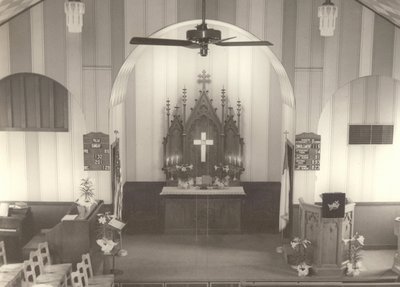 Interior third building, mid-1950's
Interior third building, mid-1950'sIn 1959 we received a lectern, which was donated by Mrs. Christine Olthoff Buskohl in memory of her mother, Mrs. Heinrich (Maria Asche) Olthoff, and Christine's first husband, George H. Geerdes.
Pastor Slottag left our congregation on February 15, 1959, to accept a call to St. Paul's in Chicago. Pastor Slottag died December 31, 1974, in Berkeley, Illinois.
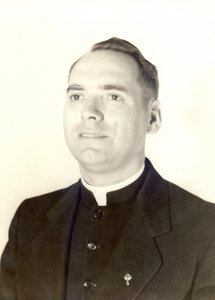 Pastor E. A. Slottag
Pastor E. A. Slottag|
--Pastor Roger Treadway with Confirmation Class-- Back row left to right: Charles Brower, Arnold Harms, Clifford Weichers, David Siefken, Rev. R. Treadway Front row left to right: Edna Harms, Linda Koch, Ruth DeVries, Bonnie Whitmire, Allen Krull |
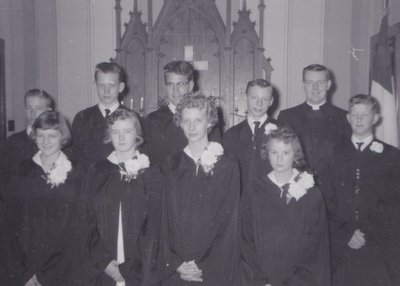 |
Our cemetery was in need of more land, but funds were low in the cemetery fund. John Peters offered to pay for a parcel of land, which was about 3 acres, from Frank Meyeraan, Sr. The price was agreed upon on November 7, 1960. Also in 1960, the church basement entrance was enclosed.
Pastor Treadway left our congregation on November 8, 1961, to accept a call to Bremer, Illinois. When Pastor Treadway left, the church council members said "We prefer a Wartburg man, but will consider one from the Iowa Synod."
Peter Carlton Larsen was our next pastor, who also came from Maywood, Illinois. He was born December 2, 1935, in Audubon, Iowa. In 1958 he received his A. B. from the University of Iowa, Iowa City, Iowa, and graduated from the Chicago Lutheran Theological Seminary in Maywood, Illnois with a B. D. in 1962. He was ordained May 14, 1962, at St. John's in Des Moines, Iowa. He was called on April 8, 1962, and came July 1, 1962. On August 5, 1961, he married (Lucy) Inetta Slagle at Baltic, Ohio. We changed from our black hymnals to the new red ones in 1962, and joined the LCA (Lutheran Church of America). This synod was a merger of a group of small synods, including our beloved Wartburg Synod.
In 1965 we, as a congregation, assisted in the organization of a new Lutheran church in Ackley, Iowa. This is Our Savior Lutheran Church.
On October 31, 1966, Pastor Larsen left for Farmington, Michigan. He later served congregations in Council Bluffs and Des Moines. During this time he did his post-graduate work and received his Ph.D. The Larsens have two children, Hans Peter and Elizabeth Inetta. At this writing, Peter Larsen is the administrator of the Danish Lutheran Home in Exira.
Dr. Marshall D. Johnson was born November 15, 1935. He graduated magna cum laude from Augsburg College in Minneapolis, Minnesota, in 1957 and also received his B.Th. degree from Augsburg in 1961. He was ordained in that same year. Pastor Johnson served as pastor of the Bronx Lutheran Church, New York, from 1961-1963. His Th.D. was from Union Theological Seminary in New York in 1966. Besides serving our church as an interim pastor, he also served as interim pastor in Cedar Falls, Iowa, and Plainfield, Iowa. Dr. Johnson was a professor of Religion at Wartburg college from 1966-1984 and head of the Religion Department at Wartburg from 1974-1977 and from 1980-1984. As of this writing, Dr. Johnson is Editorial Director for the Augsburg Fortress Publishers in Minneapolis, Minnesota.
Pastor Don Brown wrote the following in 1969: "Looking ahead to 1970, we will be celebrating St. Paul's 100th anniversary. As a congregation St. Paul's has much to remember about its past. Many have lived for Christ because of St. Paul's. It is hoped that we can make it a celebration which is worthy of the 100 years of history in which St. Paul's has been living evidence in this community of God's love."
From 1970 to October 1, 1972, we were again without a full-time pastor. Pastors Alexander and Johnson again served our congregation along with other guest pastors.
On June 1, 1972, we sent a call to Pastor Alexander's father, Pastor Clarence M. Alexander of Logansport, Indiana. He came October 1, 1972, and was installed October 22, 1972. Pastor Clarence M. N. Alexander was born July 20, 1907, son of John H. and Alma M. nee Schultz Alexander, in Omaha, Nebraska, and graduated from the South Omaha High School in 1925. He received his college education from Midland Lutheran in Fremont, Nebraska, in 1933 and the Western Theological Seminary in 1936. He was ordained May 13, 1936, in Sidney, Nebraska. Pastor Alexander married Louise Irene Pett on September 1, 1935 at Hosington, Kansas. They became the parents of three children, Dr. Ronald Alexander of Waverly, Iowa, Keith Alexander of Rapid City, South Dakota, and Lynn Alexander of Blythe, California. We were to have Pastor Alexander and his wife Louise with us until July 21, 1980, when he retired from the ministry and moved to South Dakota. The Alexanders received a new 1980 Plymouth for their travels. Pastor Alexander died in October of 1988 in Rapid City, South Dakota. "Pastor Alexander and Louise loved to recall the warmth and love they were shown while at Wellsburg. They both felt those years were a highlight of their ministry," writes Ginny Alexander of Waverly, Iowa.
Pastor Cranston R. Gesell came to us from Manson, Iowa, on January 18, 1981. He was born January 9, 1913, in Davenport, Iowa. His education was from Iowa State Teachers College in Cedar Falls, Iowa; Augustana College in Rock Island, Illinois; and Carthage College in Carthage, Wisconsin, from which he graduated in 1938. His Seminary work was done at the Chicago Lutheran Seminary, having graduated in 1941. In May of 1941 he was ordained a pastor of the Iowa Synod. On Sunday, September 13, 1981, Pastor Gesell celebrated his 40th year of ordination as a Lutheran pastor.
Pastor Gesell relinquished his position on May 1, 1984, and moved to Texas. At this writing Pastor Gesell is Editor of the Post Polio Partners.
In 1981 the church received a new Wurlitzer piano from Darrell W. Koch in memory of his late wife Nedra (Peters) Koch. Under the leadership of Pastor Gesell in 1982 we changed from the red hymnals to the new green hymnals. These are being used at the present time. They are the Lutheran Book of Worship.
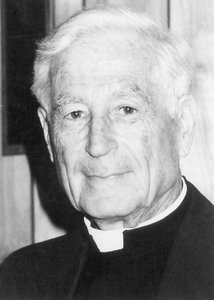 Pastor Cranston R. Gesell
Pastor Cranston R. GesellOn August 2, 1984, a call committee was selected to look for a new pastor. This committee consisted of Neil and Janice Okones, Burdette Walters, Frank and Joyce Meyeraan, Ralph DeVries and Marcia VanHeiden.
Richard L. Dowling was called on August 15, 1985, from Vinton, Iowa, and took office September 1, 1985. He was installed on September 25, 1985 and is serving as our pastor presently. During the latter 1980's we made some marked improvements at St. Paul's. In 1986 the floors were refinished in the church and the window frames were varnished. In 1987 St. Paul's had its first Directory printed with pictures of its members along with a brief history. It also contained historical and modern pictures of organizations.
In January of 1988, we as a congregation became affiliated with the ELCA (Evangelical Lutheran Church of America).
On November 5, 1989, we were saddened to hear that Pastor Dowling requested that services on December 25 be his last official act at St. Paul's. On November 26 Pastor Dowling called a special meeting and asked to be reinstated. He was unanimously re-appointed. Pastor Dowling commented that as of May 15, 1994, he became the second longest pastor to serve St. Paul's. However, to exceed Pastor Heinrich's longevity record, he says he will have to stay well past retirement. In 1989 we also had a handicap ramp installed on the south side of the church.
In 1990 new windows were installed in the church and basement. Also in 1990 the cemetery received approximately 2 acres as a gift of the estate of Lydia Meyeraan.
The years between 1991 and 1993 have been fairly eventful. The pastor's report at the end of 1993 showed a baptized membership of 215, a confirmed membership of 176 and an average attendance of 71. The budget for 1994 is in excess of $30,000.
The women of the church remain active, serving coffee after church, lunches after funerals and being involved in several fund raisers.
The youth group has been more active under Pastor Dowling's supervision. They've enjoyed bowling and swimming parties, hayrides, a "Y" lock-in each spring and also a Bible camp. The congregation enjoys their breakfast every Easter morning.
The Sunday School has an attendance of 30 children. It has always been the tradition of St. Paul's youth to give the Christmas program on Christmas eve.
In the beginning of 1994 a generous check in excess of $50,000 was given to the church by the estate of a life-long member, Ted Harms.
In a letter dated June 16, 1994, Pastor Dowling announced he accepted a call from Shepherd of the Hills Lutheran Church in Schopville, Illinois. July 17, 1994 was his last Sunday at St. Paul's.
List of Pastors
| Name | Years Served |
| Rev. Christian Hinken | 1871-1872 |
| Rev. Goettlieb Loeffler | 1873-1874 |
| Rev. Matthew During | 1875-1877 |
| Rev. Meneke Janssen Tjaden | 1877-1879 |
| Rev. W. G. Weissinger | 1879 |
| Rev. Alfred Eisenschmid, Jr. | 1879-1884 |
| Rev. Matthew Kossick | 1885-1886 |
| Rev. Dr. Joseph H. Georgi | 1886-1890 |
| Rev. Frederick G. Diekhoff | 1890-1894 |
| Rev. Otto Saalborn | 1894-1897 |
| Rev. Friedrich Conrad Wiegmann | 1897-1902 |
| Rev. Julius Koehler | 1902-1904 |
| Rev. R. Kuhne (ad interim) | 1904-1905 |
| Rev. Carl Heinrich | 1905-1936 |
| Rev. Arthur Huneke | 1936-1938 |
| Rev. Friederich J. Sager | 1938-1939 |
| Rev. F. Albin Heinz | 1940-1943 |
| Rev. Arthur William Malin | 1945-1952 |
| Rev. Ernest A. Slottag | 1952-1959 |
| Rev. Roger E. Treadway | 1959-1961 |
| Rev. Peter Carlton Larsen | 1962-1966 |
| Vacant* | 1966-1968 |
| Rev. Donald Brown | 1968-1970 |
| Vacant* | 1970-1972 |
| Rev. Clarence M. Alexander | 1972-1980 |
| Rev. Cranston R. Gesell | 1981-1984 |
| Rev. Richard L. Dowling | 1985-1994 |
| Mary Kenosian (intern) | 1994-1995 |
| Rev. Charles Ager | 1995-1999 |
| Rev. Mary Kenosian | 2001-2002 |
| Paul Toelke (intern) | 2002-2003 |
| Mark Kvale (intern) | 2003-2004 |
| Rob Nelson (intern) | 2004-2005 |
| Joel Baranko (intern) | 2005-2006 |
| Rev. Gary Burkhalter | 2006-2010 |
*Rev. Dr. Marshall D. Johnson and Rev.Dr. Ronald Alexander - interim pastors

